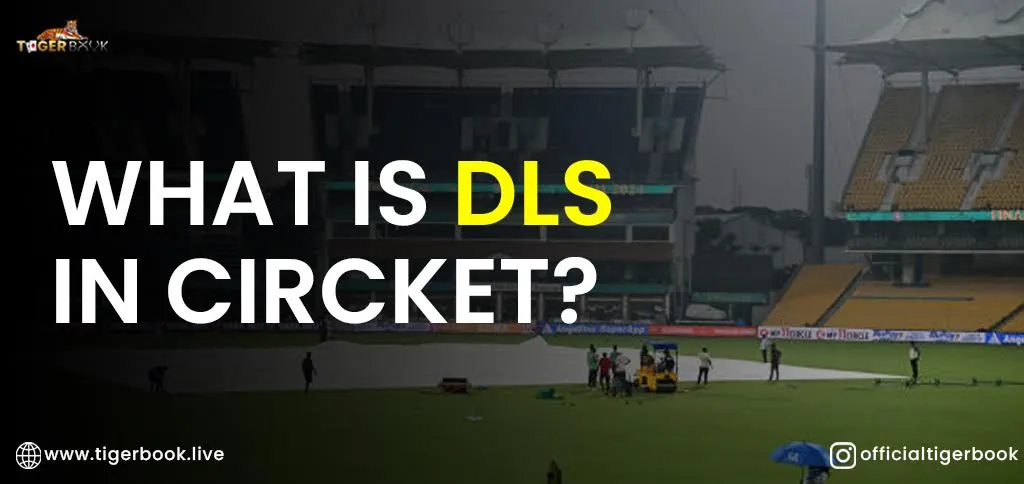
Cricket is a sport of unpredictability; as fans, when the rain ruined the match, we all got angry. Over the years, being cricket fans, you have heard the term whose name is the DLS method. To get a conclusion of the match, the association uses the DLS method. But what is the “DLS method” in cricket? Is it an actual rule in cricket?
Let’s clear the confusion; there is no DLS method in cricket. What most people mean is the DLS method, short for the Duckworth-Lewis-Stern method. In this blog, we’ll explain what the DLS method is, why people mistakenly call it the DLS method, and how it works to ensure fair results in rain-affected matches.
Let’s Understand the DLS Method
DLS refers to the Duckworth–Lewis–Stern method. It is a mathematical formula to compute target scores in rain-abandoned or weather-abandoned limited-overs cricket matches (ODIs and T20Is).
Overall, it recalculates the target score of the second team depending on how many overs and wickets the opposing side has left at the time of the disruption due to the rain. This way, both teams stand an equal chance of winning the match, even when the match is not completed.
History behind the DLS Method
The Duckworth-Lewis-Stern (DLS) system is a method of determining the outcome of a cricket game in case the match is interrupted by rain or other stoppages.
The DLS method was designed in 1997 by two English statisticians, Tony Lewis and Frank Duckworth. It is because of this that it was initially named after them as the Duckworth-Lewis method.
In 2014, an Australian professor, Steven Stern, made alterations to enhance the method, particularly for shorter matches such as T20 matches. Following his modifications, the method was rebranded as Duckworth-Lewis-Stern (DLS).
Currently, the DLS method is the International Cricket Council (ICC) official system for determining equitable results in rain-curtailed matches
Enjoy the high-stakes cricket games with Laser247 platform!!
How Does the DLS Method Work?
The DLS system is based on the principle that a team’s run-scoring capacity is dependent upon two primary resources:
- Remaining overs
- Remaining wickets
If a match is disrupted (e.g., by rain), these resources are lost. The DLS system employs a statistical formula to estimate what the team could have achieved with their available resources and then readjusts a new target for the pursuing team.
Example:
Team West Indies has 250 runs for 50 overs.
- Team Australia’s game is interrupted after 15 overs because of rain, and now they can play a maximum of 35 overs.
- The DLS system calculates a new target (not just 75% of 250); it takes into account wickets lost and overs remaining.
Per score = (75/100) x 300 = 187.5
For the Australian team new target (to win) = 189 runs in 35 overs
The aim is to maintain the scale of the game and not proportionally scale scores.
Why is the DLS Method Important?
The DLS system ensures cricket matches are fair, even in cases of rain or other issues interrupting them.
It maintains balance so that no team is given an uneven chance.
- The International Cricket Council (ICC) applies this system in all one-day and T20 international matches globally.
- DLS considers the current match situation, such as how many overs and wickets remain, to make fair choices.
Without the DLS method, there would be some cancelled or decided matches unjustly or randomly.
Criticism and Limitations of the DLS Method
Although the DLS method is highly valued, some people have reservations about it:
- Difficult to comprehend: It is difficult for many fans to comprehend, particularly when the target score changes in the middle of the game.
- T20 matches: Critics argue that it does not always prove effective for T20 matches, which can be quick.
- Change the game plan: If the target evolves suddenly, it can influence the strategy of the chasing team.
Still, the DLS method is the most reliable and widely adopted method to determine rain-affected matches.
Famous Matches That Used DLS
2019 World Cup Semi-Final: India vs New Zealand
Rain interrupted the match for two days. The DLS system assisted in controlling the game during the stoppage, but ultimately, India lost the match.
2002 Champions Trophy Final: India vs Sri Lanka
Rain hit the final as well as the reserve day for it. The DLS system was applied, but the rain refused to abate, so both teams shared the trophy.
2022 T20 World Cup: Zimbabwe vs South Africa
Rain adjusted South Africa’s target according to the DLS system. Still, the match was subsequently abandoned without any result, spurring further controversy regarding rain rules in cricket.
Conclusion
The DLS process may look complex, but it is crucial in keeping cricket fair.
Cricket is highly dependent on time, weather conditions, and the progress of the game. The DLS process applies mathematics to ensure that the match remains fair and transparent to both teams.
So, the next time there’s a sudden rain shower during a match, don’t panic; the DLS process is there to save the day.
